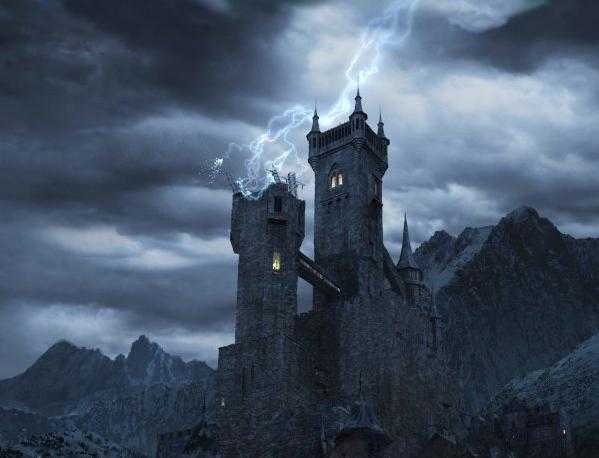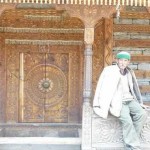A mist descends from the sky and slowly swirls around the carriage. The horses pick up pace, not because their driver is pulling tighter at the reins, but because they are as nervous as him. The carriage rattles along, spraying the dust and stones in its wake, as it moves rapidly through the only road in the forest. The traveller looks out of the window but all he can see are the dark trees. Up in the sky, the night predators circle slowly, ready to swoop down on any creature on land. But the animals don’t come out, not even the bigger ones, not even the bears. A lone wolf stands on top of a cliff jutting out from the mountains and looks on without blinking. Within minutes, evening has changed to a purple dusk. As the carriage curves with the road, a shadow swoops down and shrouds the vehicle. The horses neigh loudly, rearing their heads in fright. “Back up, back, back,” screams the traveller. It is pitch dark, and we don’t know what happens next.
Welcome to Transylvania, Romania.
It is the year 1485. A young peasant boy in Wallachia (region next to Transylvania) bursts into his home, and the family looks at him. “Vlad…” he blurts, “I saw Vlad behind the hill.” The mother lets out an anguished cry.
Vlad III has been dead for nine years. He is posthumously titled Vlad Tepes. ‘Tepes’ in Romanian means ‘Impaler’. Vlad the Impaler.
Welcome to the land of Dracula.
Sighisoara, Transylvania: It is 1431. There is celebration in the house of Draculesti. Vlad II Dracul holds the newborn baby in his hands. Over centuries, there will be tales of this day, of holy statues dripping with blood, on the day when Vlad III was born. He has three other brothers - Mircea, Vlad Calugarul aka Vlad the Monk, and Radu the Handsome.
As a boy, he was educated and thoroughly trained in warfare, science, geography and the languages. In 1447, the Hungarian Boyars rebelled against his father, Vlad Dracul, and killed him in the marshes near Balteni. His brother Mircea is blinded and burnt alive immediately thereafter. All of sixteen, Vlad III now had to establish himself as a leader in Wallachia.
Vlad’s methods were violent and terrible; blood smeared all over his crossbow, hands and soul. Anyone who dared to incur his wrath was killed brutally. Thousands of people were dragged, trailing behind as their hands were tied to horses’ feet and then impaled on spikes built around the forests surrounding his castle. Vlad and his men often galloped through the Carpathian mountains, burning down villages and razing fortresses. In fifteenth century Transylvania, the nights were heavy, burdened and cold.
According to reports, Vlad Tepes murdered between 40,000 to 80,000 people during his reign.
The 1400s see the emergence of the Crusades, and the Ottaman armies from Turkey pressed into the Eastern European countries. When the Turks sent two emissaries to his court for talks, he killed them by nailing their turbans to their heads, later saying that they did not show him respect by raising their hats.
The battles between the Turks and Vlad’s armies were bloody and the land around the Danube turned red with the number of bodies lying around it. In his letter to his ally, the king of Hungary, Vlad wrote,
“I have killed peasants men and women, old and young, who lived at Oblucitza and Novoselo, where the Danube flows into the sea, up to Rahova, which is located near Chilia, from the lower Danube up to such places as Samovit and Ghighen. We killed 23,884 Turks without counting those whom we burned in homes or the Turks whose heads were cut by our soldiers…Thus, your highness, you must know that I have broken the peace with Sultan Memed.”
There are stories of Sultan Memed, the great Conqueror of Constantinople (now Istanbul) and expert in the art of psychological warfare, vomiting and turning back from Wallachia’s capital after seeing 20,000 impaled corpses outside.
Surprisingly, Vlad Tepes became seeped in Romanian history as a hero. Despite his gruesome cruelty, Transylvania respected him for always standing up to the Ottoman Turks. All the other members of the family were branded as evil doers, even likened to the Devil.
Vlad’s son, Mihnea Cel Rau or Mihnea the Wrong Doer, was as cruel as his father. Gavril Protul, an abbot and chronicler of the times described Mihnea thus, “As soon as Mihnea began to rule he at once abandoned his sheep’s clothing and plugged up his ears like an asp…. He took all the Boyars captive, worked them hard, cruelly confiscated their property, and even slept with their wives in their presence. He cut off the noses and lips of some, others he hanged, and still others drowned.”
In December 1476, there were reports of Vlad Tepes’ assassination. His head was said to have been carried as a trophy to Constantinople, whereas the rest of his body was buried in a monastery at Comana (in Romania). Four hundred years later, Romanian historians insisted that he was not buried at Comana but in a monastery at Snagov, near his family property. In 1933, when the tomb was excavated, all that was found in the tomb were remains of animals. Did Vlad Tepes really die?
A few weeks after his supposed death, people claimed to have seen Vlad in the palace grounds, the forest, and in the hills. The rumours have still not ceased, not even five hundred years after the date.
Strangely, none of the male Draculs death dates have been recorded. This further spiked the rumors that the family was that of the Vampires. Half of the wives went mad, or committed suicide. In 1654, Prince Constatin Serban ordered that all the known Dracul graves be opened and though he never spoke of what was found, it is rumoured that there were dog bones inside.
Years after all these princes died, they were said to have been seen riding, and throwing garish parties in their palaces, reveling over the deceit of their death. Many men and woman who lived near the family property were said to have gone missing and the carcasses of animals said to have been drained of their blood were scattered all over the Vania and Bran surrounding forests. People went hysterical, claiming they had seen ravishing women appear out of the night and suddenly disappear into thin air.
Even today, people are warned from entering the Bran forests, told that the forest is haunted by Dracul princes who are undead and roaming around in search of blood. Orthodox believers insist that one should cut off the legs of the deceased, for if the undead feast on the whole body, they get access to the deceased’s living family.
Vlad Tepes, Bran Castle, the stories of the unrecorded deaths, the bloodshed, the imposing Carpathian mountains, the bodies, the folklore, the tales, the fear, the lust for the supernatural, all became an inspiration for Bram Stoker to create his wonderful novel – Dracula. Oh why do we love the unknown, the mystical, the unexplained so much.
What Bram Stoker did not realize when he wrote his novel was that it would become the most important reason for a remarkable leap in tourism for Transylvania and Romania. Romania is a beautiful country, it is full of medieval towns and fortresses and forests and hills. Yet, Transylvania gets the maximum number of international visitors. In the 20th century, visitors to Romania likened Bran Castle to the castle they had read about in the novel and in the 80s, restoration commenced in the badly maintained castle and a special ‘Dracula Room’ was inserted. Today Bran Castle has become a ‘must’ in any itinerary or traveller’s plans while visiting Romania. The country in itself received between 7 to 9 million people every year between 2008 and 2012, a large part of it because of Transylvania and the Dracula legend.
It’s funny, the man who killed thousands and thousands of people, hearing whose name people wanted to flee their homes, their country, their lives is now the reason for a million people to visit the same land.
P.S. Oh in October 2011, Prince Charles claimed he was a direct descendant of the Vlad Tepes.
———- The End ——























ThakurRajesh
Tales of #Romania: Who was Count Dracula? http://t.co/KRwZFSBh2T #adventure #featured #heritage #people #brancastle
The whole post, especially the narration in the first paragraph has been wonderfully penned, Neeraj. Any plan to write a dark thriller in the near future?:) Never read much on the legends of Dracula, but this account was totally gripping.
The amputation of the legs of the deceased reminded me of an episode of Friends, the one about Phoebe’s weird painting of a legless bald lady! Inappropriate here though. Anyways:)
Maliny, you must read Dracula by Bram Stoker. It is one of the best thrillers I have read. Of course, I read it as a child so the fascination for the supernatural, vampires and all was that much more. But no discredit to Stoker, his story is now the backbone of Romanian tourism.
Go read it now, okay? Once you are done, I’ll submit my “next thriller” to you and you can tell us which one you liked more
Roger that Though i would prefer you going ahead with your next one at the earliest to waiting up for me till i am done with the book. Or better yet, go ahead and pen a lengthier one. Maybe a novel ? There seems to be many readers for the genre.
Though i would prefer you going ahead with your next one at the earliest to waiting up for me till i am done with the book. Or better yet, go ahead and pen a lengthier one. Maybe a novel ? There seems to be many readers for the genre.
Heh, alright, I’ll pen the novel and you take care of the publishing bit? Deal?
Ha ha done
FizaPathan
Tales of Romania: Who was Count Dracula | The WAH Travel Blog http://t.co/vHlfz7mNDW via @weareholidays
Actually, Vlad tepes had nothing to do with Dracula, it was all made up

If you want the true informations, study the Romanian history more and you will agree that it was all made up by Bram Stoker.
Vlad spent his entire childhood as a hostage in turkey watching his family being butchered by turks. It was probably the reason he spiked them so hard
Hey there Tudor! Of course, we aren’t trying to say they were the same person. What we are saying is that Bram Stoker’s inspiration for Dracula was Vlad Tepes and the legend and folklore surrounding him. Vlad was cruel yes, but that he and his family were vampires or demons is just a set of old wives tales.
this was a gripping narrative!! I have not yet read Bram Stoker but you should definitely check out The Historian by Elizabeth Kostova if you have not yet had the chance! and, it was deliciously dark, - your piece
The second time someone’s mentioning ‘The Historian’ to me today Must read it now. Glad you liked the piece, I was worried if it was becoming less story-like and more factual.
Must read it now. Glad you liked the piece, I was worried if it was becoming less story-like and more factual.
Thanks for this. Had no idea there was a Dracula family, though a rather dysfunctional one by the sound of it. I fancy Radu the Handsome myself

Haha, Thursa, the only reason why I added his name was because I loved it. But you, girl, stop thurs-ting for him
My 1st time here.
Draculas…. Intersting post indeed and the sensational narration is spell binding. Keep writing Neeraj.
A lovely blog to read in leisure
Thanks a lot, Hema. And we hope that you visit a second time. Actually we hope that all the time that you have is “leisure”
Awesome post.. I had first heard of Vlad the Impaler when he took on Sun Tzu in the Deadliest Warrior series and since then my interests in dracula have increased by 10 times. What amazes me most is his cruelty, the way he tricked his foes into eating their own sons’ corpses as meat before impaling them is horrifying.
Aah, I haven’t watched that series all that much. Maybe I should. At the same time, there are a hundred other reasons to visit Romania, Soumabha, including a ride on the World’s Best Road (at least according to BBC Top Gear)
jamesbryronlove
RT @FizaPathan: Tales of Romania: Who was Count Dracula | The WAH Travel Blog http://t.co/vHlfz7mNDW via @weareholidays
that was spine chilling—thanks for all that info -enjoyed reading it